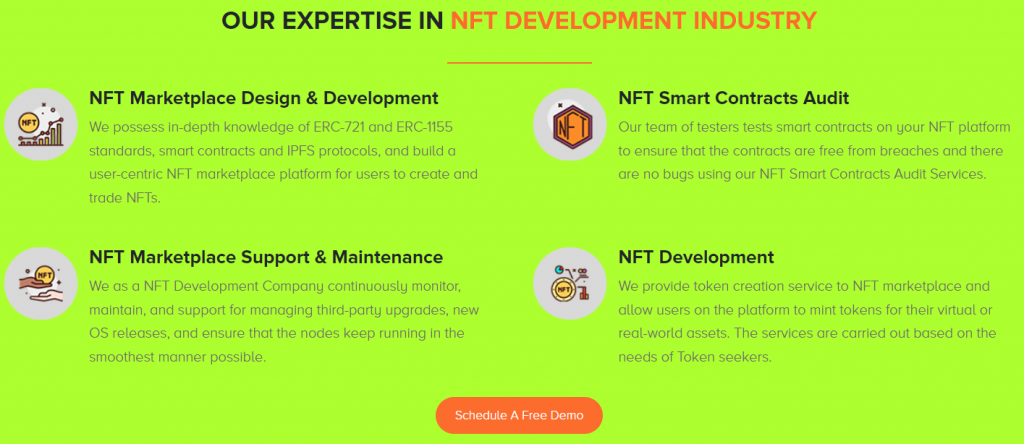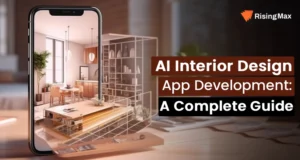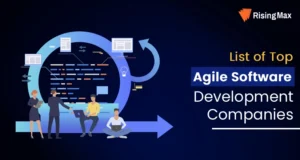NFTs are digital assets that are taking over the world at a record pace as the community of digital art collectors and creators increases. Based on Ethereum technology, each NFT is unique and can’t be replaced with any other digital assets. Any digital file such as graphics, images, photographs, music, or video can be minted into the NFT. These digital assets are traded on the NFT marketplace or App Like OpenSea, and Mintable.

Even though NFTs are built on blockchain technology, these don’t behave like cryptocurrencies. As each NFT is completely unique, these can’t be exchanged and can only be traded on the NFT marketplace. Creators are earning millions by selling their digital artwork, and investors are trading or collecting them and building their digital assets collection.
For this very reason, anyone who is interested in launching their own NFT marketplace should know about the NFT marketplace architecture diagram. This post will help you learn about the basics of NFT marketplace architecture and understand its different aspects.
NFT – Worldwide Market Forecast
- The NFT market is set to observe significant growth in the coming years. In 2023, the revenue generated from this market is forecasted to hit a staggering US$1,601 million. From 2023 to 2027, it’s predicted to grow at a Compound Annual Growth Rate (CAGR) of 18.55%, propelling the total market value to an estimated US$3,162 million by 2027.
- Each user basis is projected to contribute approximately US$114.80 to the NFT market revenue in 2023. Looking at a geographical breakdown, the United States emerges as the leader, with the country’s revenue in the NFT market expected to reach US$781.9 million in 2023.
All these facts are from Statista.
What is NFT Marketplace Architecture Diagram?
The NFT marketplace architecture is similar to software architecture. In this, the blueprint of the software system processes and necessary tasks to be executed is played. Before diving more into details, let’s start from the basics and first understand what software architecture is.
What is Software Architecture?
Architecture is the process and the product of planning, designing, and constructing buildings or other structures. The role of an architect is to design a structure by combining art and science to make every piece of a building come together in a good solution. This is just an easy example to help you understand software architecture.
NFT Software architecture is similar to architecture in which a software engineer delivers solutions by combining art and science, and instead of bricks, they use code. In simple words, it is a blueprint for the software system and lays out tasks necessary to be executed. The main focus of the software engineer is on creating the architecture rather than the implementation.
Also Read: Blockchain Companies in California
Attributes of Software Architecture & in NFT
Software architecture is a significant investment, and thus it is important to maintain good quality through the software project. That’s why it is critical to measure and evaluate meaningful measures that indicate progress and performance. Evaluate quality characteristics such as scalability, security, reliability, performance, etc. To ensure continuous improvements, here are key attributes or starter List of “Ilities” of software architecture:
- Maintainability
This attribute of the NFT marketplace architecture diagram defines the degree to which software is understood, repaired, or enhanced. This defines how flexible the software is with modification, the addition of new features, or transfer from one development team to another. However, the application must remain compliant with the software architectural rules and consistent across the application to ensure software maintainability.
- Scalability
The scalability attribute of software architecture defines the ability of the software to easily handle rapidly increasing loads without affecting its performance. In case there is an additional load, the architectures should be more than capable of supporting these increased requirements with minimal overhead. Key factors that measure scalability attributes are:
- Horizontal scaling.
- Time (in seconds) needed to increase scaling
- Limitations of scalability attributes.
- Number of servers and the possibility to scale
- Increase in the amount of content or number of transactions.
- Reliability
No software is fully risk-free, and software failure is always possible under unexpected conditions. Minimal downtime, data integrity, and no errors are the key features of a reliable NFT marketplace architecture diagram.
- Security
This software attribute provides information about the risk of software breaches, loopholes in the system, and software vulnerabilities. This information can be analyzed later to enhance or fix security and software vulnerabilities.
Match your IT needs with your business plan by partnering with a reliable NFT Marketplace Development Company.
- Simplicity
It’s the software architect’s responsibility to make the blueprint simple and easy to understand for everyone.
- Performance
This software architecture attribute determines the software response to a certain action for a certain period. Performance architecture attributes include metrics such as:
- Latency: Time is taken to respond to an event.
- Channel capacity: Total number of events that occur in a certain period of time.
- Interoperability
The interoperability attribute of the NFT architecture diagram determines the operation and transmission of data and its exchange with other external systems. A well-designed software system is easy to integrate with third-party systems.
- Extensibility
This software architecture attribute determines the ability of the software to handle additional components and new functionalities. Extensibility is vital for a flexible software development process and adding new features/components to the application in the future.
- Rate of Delivery
Software, along with time, typically goes through various improvements and addition to new features. The rate of delivery is the ability of how often the software can go through revisions and shipped to customers.
- Testability
The testability feature is an assurance that software is tested multiple times before reaching the end users. Finding faults in software requires a high degree of testability but is a must to deploy error-free applications into production.
Now you know what software architecture is and why it’s so important. Let’s move further to the next section and understand the problems that arise due to bad software architecture.

What Are The Problems That Arise Due To Bad NFT Marketplace Architecture?
Software architecture is an important part of software development. Laying down a good blueprint for the application is important to ensure everything works synchronously and in perfect harmony. However, the effects of bad software architecture can be seen easily. Here are a few examples of the issues that arise due to bad software architecture:
- Maintenance issues
Bad software architecture might result in maintenance issues and even adding basic features seems difficult. Where in an application, everything works synchronously and issues in one part of the application might break in other parts.
- Integration issues
The next issue that comes with bad software architecture is integration with other apps. Users will have to use multiple apps to access related information, thus making the application complex to use.
- Scalability issues
With time the application needs support to meet the increasing user demand and add new features. Bad architecture hampers the software’s ability to scale when needed or makes it harder to scale.
- Limited options
Bad software architecture limits the business growth opportunities and chooses an inferior option or stick with the current setup.
- Limited life span
As with bad software, architecture businesses are left out with fewer options to grow or even maintain a certain growth level. The only option you will have is to stick with the older version or choose an inferior option, thus limiting the lifespan of the application.

What Features To Keep in Mind While Creating NFT Marketplace Architecture?
While creating an NFT marketplace architecture diagram, keep in mind the features that you can add to your NFT marketplace to make it unique. Here are some features that you can add to your platform.
- Liquidity – The NFT marketplace is an extremely volatile market as millions of dollars worth of digital assets are traded online. Your marketplace allows users to trade digital tokens and is accessible to the trading community worldwide.
- User-friendly – Your platform has all the basic features, easy to use and understand, especially for beginners.
- Crypto wallet – To facilitate buying and selling digital assets, a crypto wallet is necessary. Multi-wallet integration is also a vital feature that allows users to join your platform with their existing wallets.
- Search Filters – These are extremely helpful features that allow users to easily find specific kinds of NFTs.
- Decentralization – The decentralized nature of blockchain technology ensures that in the NFT marketplace:
- Nothing is kept centrally.
- All the transactions are securely distributed over the network.
- When a new block is, each server within the network reflects the change.
- In case there is a hacking attempt, the system must keep only a single copy of the information.
6. Transparency – The platform exhibits transparency, and users have a clear picture of the transaction and everything happening over the network.
7. Security – As digital assets worth millions are traded over these networks, security becomes the top priority for users. Smart contracts, decentralization, and blockchain security make the platform completely safe and secure.
Steps Involved in NFT Marketplace Development:
- Analysis of Business Requirements and Defining a Niche: Understand the needs of your target audience, decide on the technology, and define your unique selling points and the niche you want to focus on.
- Discovery Stage and Launching the Blockchain Network: Plan the design and features of your marketplace architecture, and select the appropriate blockchain network.
- UX/UI Design and Creating Smart Contracts: Develop a user-friendly interface and design the smart contracts that will mint the NFTs and trigger transactions.
- NFT Platform Development and Implementing the Marketplace: Begin the actual development of your platform, ensuring integration between backend and frontend. Create a marketplace where sellers can list their assets and buyers can purchase tokens.
- Integrating Crypto Payment Gateways: Incorporate cryptocurrency payment gateways to enable buying, selling, and transferring of NFTs, and payment for marketplace services.
- Quality Assurance and Establishing Security: Perform multiple rounds of testing to ensure the platform functions correctly and implement robust security measures to protect the marketplace and its data.
- Project Release: Plan and execute the launch of your NFT marketplace, and use marketing strategies to attract creators and buyers.
- Post-release Support: Regularly update and improve your platform based on user feedback and changes in the market.
Technology stack for NFT marketplace development:
|
Component |
Technology Options |
|
Blockchain Network |
Ethereum, Binance Smart Chain, Flow, Polkadot, Tezos |
|
Smart Contract Language |
Solidity, Vyper (Ethereum), Rust, C++ (EOS) |
|
Front-end Development |
HTML5, CSS3, JavaScript, React.js, Vue.js |
|
Back-end Development |
Node.js, Express.js, Python, Django |
|
Database |
MongoDB, PostgreSQL |
|
Payment Gateway |
BitPay, CoinGate, Coinbase Commerce |
|
NFT Standards |
ERC-721, ERC-1155, FA2, TRC-721 |
|
Security |
Asymmetric Data Encryption, APIs Authorization Controls, AI-Powered Fraud Detection Algorithms |
|
Web3 Libraries |
Web3.js, Ether.js |
|
IPFS Storage |
IPFS, Filecoin |
|
Wallet Integration |
Metamask, WalletConnect, Portis |
Wrapping Up
Building and launching your own NFT marketplace seems to be a profitable business idea, seeing the popularity of these digital assets. Crypto traders, digital art collectors, creators, and business owners are all earning a fair share in this highly profitable market. While our experts at RisingMax work on creating an NFT marketplace architecture diagram for your new platform. As our team dwells on the most vital aspect of the development process, you can plan on other aspects such as features, revenue model, tech stack, etc.












